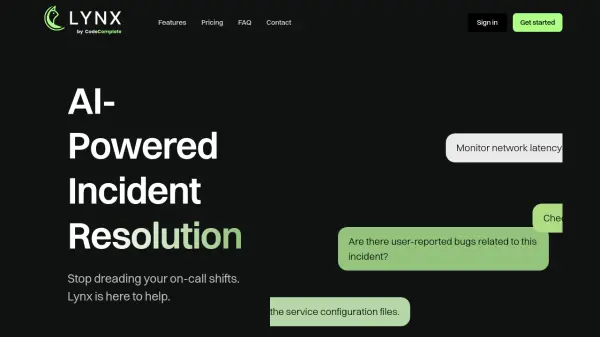What is Lynx?
Leverage artificial intelligence to enhance incident resolution processes. This platform initiates analysis immediately upon incident occurrence, providing engineers with necessary context promptly. It goes beyond diagnostics by directly addressing issues within code and infrastructure, guiding towards stable solutions. The system employs adaptive context retrieval, gathering essential real-time data from infrastructure, logs, pipelines, and codebases for a comprehensive understanding.
Integrate seamlessly with existing tools and environments for end-to-end support. An integrated Unix shell allows direct command execution and code implementation on machines, governed by robust safety measures including AI-driven risk detection, role-based access controls (RBAC), audit logging, and command approvals. It also fosters team collaboration by intelligently routing incidents to appropriate personnel and automatically logging investigation steps, which can be converted into runbooks and postmortems, thereby enhancing operational efficiency and reducing system disruptions.
Features
- Automated Root Cause Resolution: AI automatically identifies the source of incidents.
- Instant Analysis: Begins analyzing incidents immediately as they occur.
- Action-Driven Resolution: Directly resolves issues in code and infrastructure.
- Adaptive Context Retrieval: Automatically pulls critical real-time information from infrastructure, logs, pipelines, and codebase.
- Comprehensive Integrations: Connects with a wide range of tools and environments.
- Integrated Unix Shell: Allows direct command execution on machines.
- Safe Execution Controls: Includes AI-driven risk detection, RBAC, audit logging, and command approvals.
- Team Collaboration: Routes incidents to the right people and logs resolution steps.
- Workflow Publishing: Transforms logged steps into runbooks and postmortems.
Use Cases
- Automating incident investigation and diagnosis.
- Resolving code and infrastructure issues directly.
- Reducing mean time to resolution (MTTR) for incidents.
- Streamlining on-call responsibilities for engineers.
- Debugging CI/CD pipelines.
- Analyzing error logs for exceptions.
- Executing commands securely in production environments.
- Generating runbooks from incident resolution steps.
- Facilitating collaboration among response teams.
FAQs
-
What does Lynx do?
Lynx is an AI-powered incident resolution platform that helps engineers investigate and resolve issues directly within their environment. It automates information gathering, suggests resolutions, and can perform actions to fix problems, making incident investigation more efficient. -
Who is Lynx for?
Lynx is designed for engineering and DevOps teams needing efficient incident management, particularly those dealing with demanding on-call rotations, aiming to reduce response times and on-call burdens. -
Can I deploy Lynx on-prem or in my private cloud?
Yes, Lynx supports deployment both on-premises and in private clouds. It can also accommodate custom LLM configurations or on-prem models. -
Is Lynx safe?
Yes, Lynx incorporates enterprise-grade security features like end-to-end encryption, data segmentation, MFA/SSO support, and customer-controlled data retention. For execution safety, it includes RBAC, command blacklisting, optional execution sandboxing, validation protocols, and comprehensive logging.
Related Queries
Helpful for people in the following professions
Lynx Uptime Monitor
Average Uptime
100%
Average Response Time
283.07 ms
Featured Tools
Join Our Newsletter
Stay updated with the latest AI tools, news, and offers by subscribing to our weekly newsletter.











